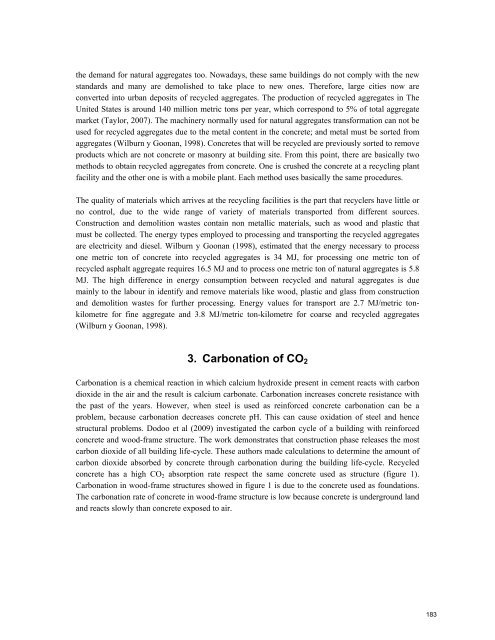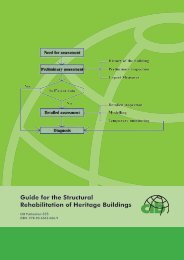CIB W116âSmart and Sustainable Built Environments - Test Input
CIB W116âSmart and Sustainable Built Environments - Test Input
CIB W116âSmart and Sustainable Built Environments - Test Input
Create successful ePaper yourself
Turn your PDF publications into a flip-book with our unique Google optimized e-Paper software.
the dem<strong>and</strong> for natural aggregates too. Nowadays, these same buildings do not comply with the new<br />
st<strong>and</strong>ards <strong>and</strong> many are demolished to take place to new ones. Therefore, large cities now are<br />
converted into urban deposits of recycled aggregates. The production of recycled aggregates in The<br />
United States is around 140 million metric tons per year, which correspond to 5% of total aggregate<br />
market (Taylor, 2007). The machinery normally used for natural aggregates transformation can not be<br />
used for recycled aggregates due to the metal content in the concrete; <strong>and</strong> metal must be sorted from<br />
aggregates (Wilburn y Goonan, 1998). Concretes that will be recycled are previously sorted to remove<br />
products which are not concrete or masonry at building site. From this point, there are basically two<br />
methods to obtain recycled aggregates from concrete. One is crushed the concrete at a recycling plant<br />
facility <strong>and</strong> the other one is with a mobile plant. Each method uses basically the same procedures.<br />
The quality of materials which arrives at the recycling facilities is the part that recyclers have little or<br />
no control, due to the wide range of variety of materials transported from different sources.<br />
Construction <strong>and</strong> demolition wastes contain non metallic materials, such as wood <strong>and</strong> plastic that<br />
must be collected. The energy types employed to processing <strong>and</strong> transporting the recycled aggregates<br />
are electricity <strong>and</strong> diesel. Wilburn y Goonan (1998), estimated that the energy necessary to process<br />
one metric ton of concrete into recycled aggregates is 34 MJ, for processing one metric ton of<br />
recycled asphalt aggregate requires 16.5 MJ <strong>and</strong> to process one metric ton of natural aggregates is 5.8<br />
MJ. The high difference in energy consumption between recycled <strong>and</strong> natural aggregates is due<br />
mainly to the labour in identify <strong>and</strong> remove materials like wood, plastic <strong>and</strong> glass from construction<br />
<strong>and</strong> demolition wastes for further processing. Energy values for transport are 2.7 MJ/metric tonkilometre<br />
for fine aggregate <strong>and</strong> 3.8 MJ/metric ton-kilometre for coarse <strong>and</strong> recycled aggregates<br />
(Wilburn y Goonan, 1998).<br />
3. Carbonation of CO 2<br />
Carbonation is a chemical reaction in which calcium hydroxide present in cement reacts with carbon<br />
dioxide in the air <strong>and</strong> the result is calcium carbonate. Carbonation increases concrete resistance with<br />
the past of the years. However, when steel is used as reinforced concrete carbonation can be a<br />
problem, because carbonation decreases concrete pH. This can cause oxidation of steel <strong>and</strong> hence<br />
structural problems. Dodoo et al (2009) investigated the carbon cycle of a building with reinforced<br />
concrete <strong>and</strong> wood-frame structure. The work demonstrates that construction phase releases the most<br />
carbon dioxide of all building life-cycle. These authors made calculations to determine the amount of<br />
carbon dioxide absorbed by concrete through carbonation during the building life-cycle. Recycled<br />
concrete has a high CO 2 absorption rate respect the same concrete used as structure (figure 1).<br />
Carbonation in wood-frame structures showed in figure 1 is due to the concrete used as foundations.<br />
The carbonation rate of concrete in wood-frame structure is low because concrete is underground l<strong>and</strong><br />
<strong>and</strong> reacts slowly than concrete exposed to air.<br />
183

















